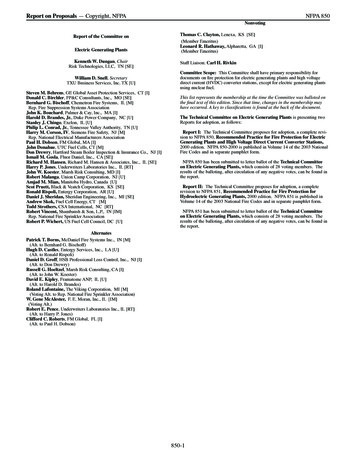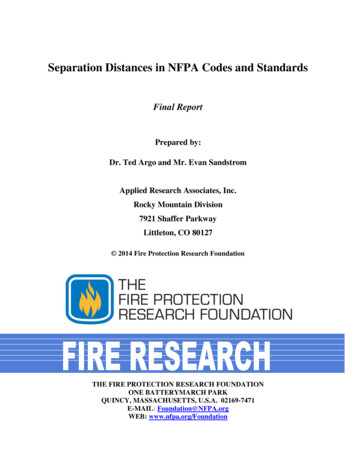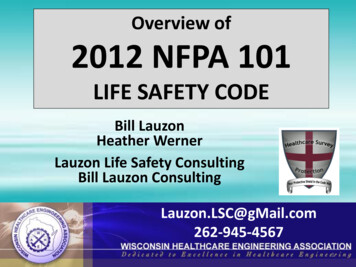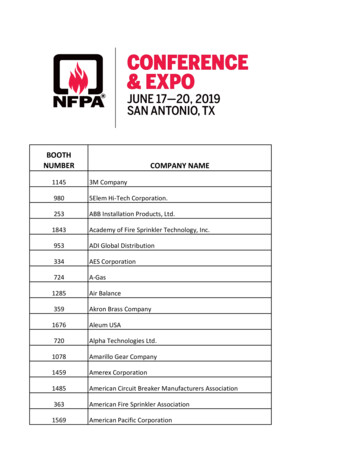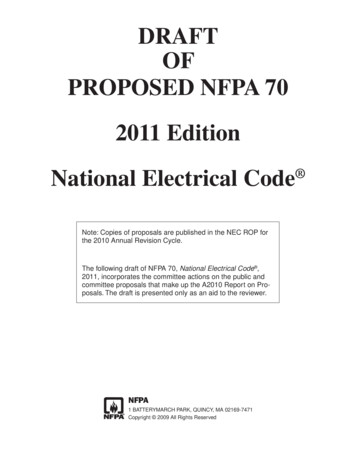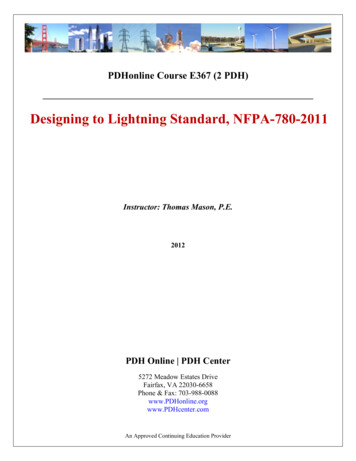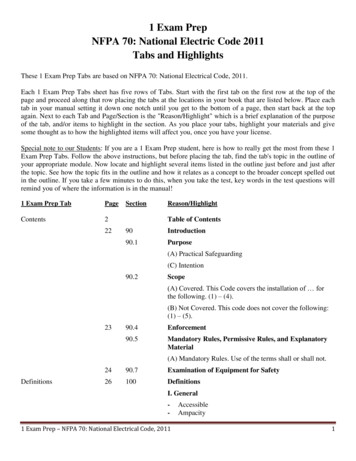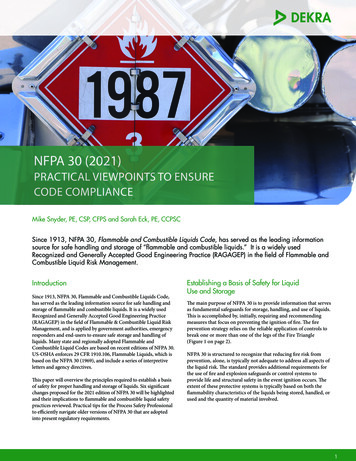
Transcription
NFPA 30 (2021)PRACTICAL VIEWPOINTS TO ENSURECODE COMPLIANCEMike Snyder, PE, CSP, CFPS and Sarah Eck, PE, CCPSCSince 1913, NFPA 30, Flammable and Combustible Liquids Code, has served as the leading informationsource for safe handling and storage of “flammable and combustible liquids.” It is a widely usedRecognized and Generally Accepted Good Engineering Practice (RAGAGEP) in the field of Flammable andCombustible Liquid Risk Management.IntroductionSince 1913, NFPA 30, Flammable and Combustible Liquids Code,has served as the leading information source for safe handling andstorage of flammable and combustible liquids. It is a widely usedRecognized and Generally Accepted Good Engineering Practice(RAGAGEP) in the field of Flammable & Combustible Liquid RiskManagement, and is applied by government authorities, emergencyresponders and end-users to ensure safe storage and handling ofliquids. Many state and regionally adopted Flammable andCombustible Liquid Codes are based on recent editions of NFPA 30.US-OSHA enforces 29 CFR 1910.106, Flammable Liquids, which isbased on the NFPA 30 (1969), and include a series of interpretiveletters and agency directives.This paper will overview the principles required to establish a basisof safety for proper handling and storage of liquids. Six significantchanges proposed for the 2021 edition of NFPA 30 will be highlightedand their implications to flammable and combustible liquid safetypractices reviewed. Practical tips for the Process Safety Professionalto efficiently navigate older versions of NFPA 30 that are adoptedinto present regulatory requirements.Establishing a Basis of Safety for LiquidUse and StorageThe main purpose of NFPA 30 is to provide information that servesas fundamental safeguards for storage, handling, and use of liquids.This is accomplished by, initially, requiring and recommendingmeasures that focus on preventing the ignition of fire. The fireprevention strategy relies on the reliable application of controls tobreak one or more than one of the legs of the Fire Triangle(Figure 1 on page 2).NFPA 30 is structured to recognize that reducing fire risk fromprevention, alone, is typically not adequate to address all aspects ofthe liquid risk. The standard provides additional requirements forthe use of fire and explosion safeguards or control systems toprovide life and structural safety in the event ignition occurs. Theextent of these protective systems is typically based on both theflammability characteristics of the liquids being stored, handled, orused and the quantity of material involved.1
Figure 1: The Fire TriangleFUEL Proper design of containers, piping, and tanks to reduce leakageand to provide containment of liquid in early stages offire exposure Use of low level and local exhaust ventilation to preventaccumulation of flammable vapors Operational procedures to control emissions from Class Iliquids in containers and tanks Housekeeping practice to control fuel sources that couldprovide initial fire exposure to liquids in use and storage Use of flash arrestor systems to limit exposure of flammablevapors within the headspace of tanksAIR/OXIDANT In limited situations, container transfers and tank headspacescan have oxygen concentration lowered through theintroduction of an inert gas. The basis of safety is to ensure that the oxygen concentration isreliably held below the lower oxygen concentration limitrequired for combustion. Personnel safety must be carefully considered when usingthis strategy to avoid worker exposure to asphyxiation risks.IGNITION SOURCES Section 6.5 of NFPA 30 provides an overview of fundamentalstrategies, focusing on 12 common sources of ignition inliquid operations Key focus on adequate electrical (hazardous) area classification(Chapter 7) Controls for electrostatic risks, particularly when transferring anddispensing liquids Control of hot work operationsThe fire and explosion safeguards typically utilized in NFPA 30 include: Drainage & containment Facility design, including use of fire walls, fire resistiveconstruction, and separation distances Fixed fire protection systems Emergency Plans Explosion protection (containment, relief venting, explosionsuppression)NOTE: Focus on this protection is needed when handling liquidsthat are highly volatile (Class IA & IB) or are chemically unstable.Overview of NFPA 30NFPA 30, Flammable and Combustible Liquids Code, is a widely usedRecognized and Generally Accepted Good Engineering Practice(RAGAGEP) in the field of Flammable & Combustible Liquid RiskManagement. It is applied by government authorities, emergencyresponders and end-users to ensure safe storage and handling of liquids.NFPA 30 has been developed and updated through NFPA’s standardsdevelopment process that is a full, open, consensus-based process.NFPA 30 is revised and updated approximately every three years.The standard’s cycle takes approximately two years to complete.Each revision cycle proceeds according to a published schedule,which includes final dates for each stage in the standards developmentprocess, and provides several opportunities for all members of thepublic to provide input and commentary for changing, updating, andimproving the standard. This information is tracked on theDocument Info pages for each standard1.The four fundamental steps in the NFPA standards developmentprocess are: Public Input Public Comment NFPA Technical Meeting NFPA Standards Council Action (Appeals and Issuance ofStandard)The Regulations Governing the Development of NFPA Standardsdetail the procedures used during each step of the NFPA 30Standards development process2.2
NFPA Technical Committees serve as the principal consensus bodiesresponsible for developing and updating all NFPA codes andstandards. Committee members appointed by the NFPA StandardsCouncil, representing a balance of interests. NFPA membership is notrequired in order to participate on a NFPA Technical Committee.Appointment to a Technical Committee is based on such factors astechnical expertise, professional standing, commitment to publicsafety, and the ability to bring to the table the point of view of acategory of interested people or groups.Due to the comprehensive nature of NFPA 30, there are four technicalcommittees and one correlating committee that managethe standard’s revision and update. The purpose of the correlatingcommittee is to manage and coordinate the activities of the fourtechnical committees involved with NFPA 30 and to ensure that thedocument sections managed by each technical committee do notcontain conflicts or inconsistencies. The responsibilities for the fourtechnical committees (Fundamentals, Operations, Storage & Warehousing,and Tank Storage & Piping Systems) are summarized in Table 1.Common Methods for Safe Storage andHandling of Flammable LiquidsNFPA 30 is a widely used Recognized and Generally Accepted GoodEngineering Practice (RAGAGEP) in the field of flammable andcombustible liquid risk management. It is routinely applied bygovernment authorities, emergency responders and end-users toensure safe storage and handling of liquids. Successful management offlammable liquid risks are most efficiently provided by understandingthe structure of NFPA 30 and the source of its requirements andrecommendations. This allows one to effectively use this informationfor the design and operation of liquids operations.Table 1: Topical Coverage and Application of NFPA 30 ChaptersChapterApplicationNFPA TechnicalCommittee1-7 (5 is reserved)Requirements for all facilities where liquids are stored, handled, or usedFundamentals8Reserved9 through 12Storage of liquids in containers, portable tanks, and intermediate bulkcontainers in the occupancies covered by each chapter’s scope13Storage of liquids in containers, portable tanks, and intermediate bulkcontainers in detached unprotected buildings14Storage of liquids in containers, portable tanks, and intermediate bulkcontainers in hazardous materials storage lockers15Outdoor storage of liquids in containers, portable tanks, andintermediate bulk containers16Fire protection design criteria used to protect storage of liquid incontainers, portable tanks, and intermediate bulk containers17Design and construction of facilities where liquids are processed or used18General requirements related to handling, dispensing, transfer, anduse of liquids19Specific equipment & operations that use liquids (recirculating heattransfer systems, vapor recovery & processing systems, solvent distillation,and cooking oil storage tanks in commercial kitchens)20Reserved21 through 25Bulk storage of liquids in tanks.27Piping systems for transferring liquids28Loading and unloading systems associated with bulk storage ofliquids in tanks29Storage & Warehousingof Containers & PortableTanks (FLC-SWC)Operations (FLC-OPS)Tank Storage & PipingSystems (FLC-TAN)Operations (FLC-OPS)Wharves associated with bulk handling of liquids3
NFPA 30 provides several options for facility and tank design for thestorage, use, and handling of liquids. The options available aregenerally based on the hazards presented by the commodity (flashpoint & boiling point), construction of containers (or tanks) used,and the configuration of storage or use.As an example, Chapters 9 through 16 of NFPA 30 provide number ofoptions are available for storage of liquids in containers. Dependingon the risks involved and protection provided, the volume of storageis limited – which allows several design options based on operationalneeds. The options available in storage situations include: Storage configurations in detached, unprotected buildings Storage configurations in hazardous materials lockers Outdoor storage configurations Indoor protected storage (large quantities in specificconfigurations) Indoor unprotected storage (limited quantities andconfigurations)A commonly overlooked requirement from Chapter 17 is that processingand handling of Class II and Class III liquids heated at or above theirflash point shall follow the requirements for Class I liquids, unless anengineering evaluation conducted in accordance with Chapter 6justifies following the requirements for some other (lower hazard)liquid class.Navigating Code Requirements WithLegacy Versions of NFPA 30Generally, NFPA 30 is adopted as part of a local or state levelFlammable & Combustible Liquids Code through legislative action.Often, the adopted version is from one or two code cycles earlier thanthe most current version, and local amendments may be made.The most common amendment is to limit the coverage of the codeto liquids with flash points below 200F (93C). NFPA 30 Annex Hprovides guidance for adopting the standard in a local jurisdiction.When faced with a local adoption of NFPA 30, it is essential that youhave access to both the edition of NFPA 30 that was adopted, as wellas a copy of any amendments made during the adoption process.For example, the state of Michigan has adopted the 2012 edition ofNFPA 30 and issued a series of amendments3 that both limit theapplication of the standard to liquids with flash points below200 F (93 C) and direct certain state activities for inspection andreview to specific departments. For facilities subject to NFPA 30, thisinformation will be necessary to ensure that both current operationsand new projects are conducted in accordance with the specificstate requirements.Typically, when a jurisdiction has adopted an older version of NFPA 30and you desire to use features from newer editions, there are varianceprocedures that can be applied. Generally, the responsibility is placedon the variance requester to demonstrate that the proposed approachprovides equivalent safety to the original requirement. With adequatejustification, these requests are often approved. The key to success isto engage the local fire code authority early in the process, to discussthe specific details of the request and align on the best way to accomplishthe desired objectives.OSHA 1910.106 (Flammable Liquid Standard) is based on the 1969edition of NFPA 30. The OSHA standard has been given a limitedupdate to incorporate Globally Harmonized System (GHS) terminology(Categories) along with agency directives to address the introductionof plastic containers that did not exist when the 1969 edition waspublished4.In 1995, OSHA produced a letter of interpretation that allowedfacility owners to use a more current version of NFPA 30 in lieu of theolder requirements in 1910.1065. OSHA states that they will acceptlater editions of consensus standards (such as NFPA 30) when thoselater editions set forth requirements which are as protective as currentrequirements of the standard. In such situations, the employer has theburden of proof to demonstrate that the protective measuresimplemented are in fact equivalently protective.Table 2: OSHA Citations Against 1910.106 (2010 – 2019) – 71% of Citations IssuedOSHA SectionCoverage AreaNumber of Citations1910.106 (e)(6)Sources of ignition17211910.106 (e)(2)Incidental storage or use of flammable liquids13791910.106 (d)(2)Design, construction, and capacity of containers10871910.106 (e)(9)Housekeeping7681910.106 (d)(4)Design and construction of inside storage rooms6341910.106 (g)(3)Service stations: Dispensing systems5071910.106 (d)(3)Design, construction, and capacity of storage cabinets5054
OSHA’s Citation History Involving 1910.106(Flammable Liquids Standard)Key Changes Proposed for NFPA 30(2021 Edition)As previously referenced, OSHA 1910.106 (Flammable LiquidStandard) is based on the 1969 edition of NFPA 30. The OSHAstandard has been given a limited update to incorporate GloballyHarmonized System (GHS) terminology along with agency directivesto address the introduction of plastic containers that did not existwhen the 1969 edition was published. The OSHA Standard applies toflammable liquids divided into four GHS categories. The standardscope covers liquids with flash points below 199.4 F (93 C) or anyli
For example, the state of Michigan has adopted the 2012 edition of NFPA 30 and issued a series of amendments3 that both limit the application of the standard to liquids with flash points below 200 F (93 C) and direct certain state activities for inspection and review to specific departments. For facilities subject to NFPA 30, this information will be necessary to ensure that both current .
